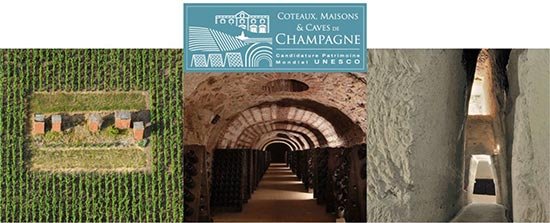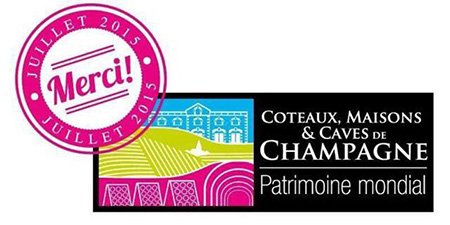|
|
| |
|
| Champagne is World Heritage |
| By vino india |
| Twenty one representatives of the State Parties to the UNESCO World Heritage Convention that met in Bonn, Germany for their 39th session unanimously voted in favour of including the Coteaux, Maisons & Caves de Champagne (Hillsides, Houses & Cellars of Champagne) to the World Heritage List. Another dossier of "Les climats du vignoble de Bourgogne" was also inscibed, making it a double win for France. |
| |
|
| |
| As the Chairperson of the World Heritage Committee rang her gavel (she later remarked that a bottle of champagne should have been opened) to announce "adopted", the French delegation broke into a loud cheer, one that resonated around the world. The champenois celebrated this historic decision in Hautvillers – as homage to the icon Dom Pérignon who had shared 'stars' in a glass of wine with the world. |
| The Champagne region is no stranger to world heritage honour – the Notre-Dame Cathedral, the Palais du Tau, the Basilique & Musée St Rémi in Reims – all are World Heritage Sites. None the less, this latest UNESCO announcement got the Champenois celebrating as it recognises almost three centuries of the unique viticulture and vinification in champagne. |
| The reactions |
| President François Hollande welcomed the decision to recognise the exceptional heritage of Burgundy and Champagne and described the regions as the "wealth of France". |
| Pascal Férat, President of the Syndicat Général des Vignerons de la Champagne was delighted. "This inscription enshrines our appellation, how the industry is organized and its production methods, and the excellence of its products." |
| Jean-Marie Barillère, President of the Union des Maisons de Champagne said "the pioneers enabled champagne – a symbol of reconciliation and celebration – to go global. We are duty bound to enhance this wonderful legacy for future generations." |
| Pierre-Emmanuel Taittinger, President of Champagne Taittinger believes that this "is recognition for the work of our ancestors, their know-how, our history, wine growing, production and selling for over 1,000 years." |
| The inscription |
| The inclusion of Coteaux, Maisons & Caves de Champagne recognizes the unique heritage of the region, the know-how of the people who have benchmarked the champagne production process, and encourages the efforts to conserve and develop vineyard landscapes. |
| The Exceptional Universal Value of the Champagne vineyard landscape, the birthplace of Champagne wine, has been recognised… and in a broader sense, this includes all the work done to grow the grapes, produce Champagne wine and distribute it around the world – something that is passed down the generations and preserved in the Champagne appellation districts. |
| In addition, the inscription was on the basis of having met the following three (out of the ten) selection criteria: |
- |
to bear a unique or at least exceptional testimony to a cultural tradition or to a civilization which is living or which has disappeared; |
- |
to be an outstanding example of a type of building, architectural or technological ensemble or landscape which illustrates significant stages in human history; |
- |
to be directly or tangibly associated with events or living traditions, with ideas, or with beliefs, with artistic and literary works of outstanding universal significance. |
|
|
| About the coveted World Heritage tag |
| The Convention concerning the Protection of the World Cultural and Natural Heritage is an international treaty that was adopted by UNESCO in 1972 to encourage the identification, protection and preservation of natural heritage around the world which are considered to be of outstanding value to humanity. The cultural landscapes category was created in 1992 to designate combined works of nature and of man, that goes further than the monument or site itself and shows how human activity is the source of new landscapes and a particular culture. |
| World Heritage Sites reflect the wealth and diversity of the Earth’s cultural and natural heritage and are inscribed on the basis of "exceptional universal value". They belong to all the people of the world, irrespective of the territory on which they are located and it is duty of the international community as a whole to cooperate for their protection. |
| UNESCO has recognised vineyards before – Lavaux in Switzerland and Douro in Portugal for spectacular beauty; Pico Island in the Azores for exceptional beauty; Tokaj in Hungary and Saint-Emilion in France for their historic nature. |
| Champagne’s pitch |
| The Association Paysages du Champagne was founded in 2008 under the dynamic leadership of Pierre Cheval, wine-grower and head of Champagne Gatinois in Aÿ, who spearheaded work on the extremely rigorous application process on behalf of all the stakeholders in the AOC Champagne area. |
| |
|
Pierre Cheval |
| |
| A collective campaign, it generated massive support from the local community – close to 53,000 ambassadors supported the application! All 320 districts in the AOC Champagne area joined the association. Knowledge-sharing tools were created to publicize champagne’s heritage and convey this to the future generations. |
| Pierre Cheval felt "great satisfaction and collective delight! The Champagne Region is a symbol of fraternity, even though the region has experienced more than its fair share of dark moments Its inclusion is an undertaking to the world’s nations, so we must be worthy of it. We have a date with history, our very own history!" |
| What next? |
| According to Thibaut Le Mailloux, Director of Communications at Comité Champagne, the World Heritage tag is an encouragement to further increase the quality in hospitality and tourism facilities while developing sustainable viticulture. As in the case of any newly recognized site by UNESCO, an increase of 20-30% in tourist footfalls in the region can be expected. |
| Site inscription criteria are very stringent and all inscriptions are re-evaluated every six years! Thus stakeholders must demonstrate their capacity to manage and protect the site. Keeping this in mind, the association has developed a conscientious management plan based on long-term guidelines for conservation, phased initiatives, evaluation indicators and voluntary undertakings to preserve and develop the landscapes. |
| |
|
| |
| A perfect occasion to pop the bottle and toast to the bubbles. |
| vino india brings you an insight into the inclusion of the Hillsides, Houses & Cellars of Champagne in the UNESCO World Heritage List. Please share any feedback with vino india info@vinoindia.in |
|
|
|
|
















